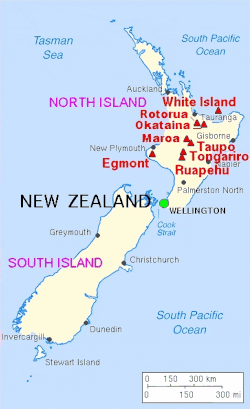North Island
Taupō Volcanic Zone

This is a partial list of active, dormant, and extinct volcanoes in New Zealand.

| Name | Elevation | Location | Last eruption | |
|---|---|---|---|---|
| meters | feet | Coordinates | ||
| Mount Somers | 1,688 | 5,538 | 43.70°S 171.40°E | 89 million years ago |
| Akaroa Volcano | - | - | 43°48′S172°57′E / 43.800°S 172.950°E | Miocene |
| Dunedin Volcano | 680 | 2218 | 45°49′S170°39′E / 45.817°S 170.650°E | c. 10 million years ago [17] |
| Mount Horrible (near Timaru) | - | - | 44°23′S171°3′E / 44.383°S 171.050°E | 2 million years ago [18] |
| Lyttelton Volcano | 919 | 3010 | 43°36′S172°43′E / 43.600°S 172.717°E | Miocene |
| Name | Elevation | Location | Last eruption | |
|---|---|---|---|---|
| meters | feet | Coordinates | ||
| Antipodes Islands | 402 | 1319 | 49°41′S178°46′E / 49.68°S 178.77°E | Holocene |
| Auckland Island | 650 | 1981 | 50°41′S166°05′E / 50.69°S 166.08°E | Miocene [19] |
| Mount Dick (Adams Island) [20] | 705 | 2313 | 50°52′28″S166°4′55″E / 50.87444°S 166.08194°E | - |
| Pitt Island | 241 | 791 | 44°11′S176°08′W / 44.18°S 176.13°W | Ancient[ vague ] |
| Solander Islands | 330 | 1080 | 46°34′S166°53′E / 46.567°S 166.883°E | Pleistocene |
New Zealand also has de facto administration over Ross Dependency in Antarctica, which contains the following volcanoes:
| Name | Elevation | Location | Last eruption | |
|---|---|---|---|---|
| meters | feet | Coordinates | ||
| Mount Bird (Ross Island) | 1765 | 5791 | 77°16′S166°45′E / 77.267°S 166.750°E | 3.8 million years ago [21] |
| Brown Peak (Sturge Island, Balleny Islands) | 1500 | 5000 | 67°24′S164°50′E / 67.400°S 164.833°E | 2001 |
| Buckle Island (Balleny Islands) | 1239 | 4065 | 66°48′S163°15′E / 66.800°S 163.250°E | 1899 |
| Mount Discovery (Scott Coast) | 2681 | 8796 | 78°22′S166°01′E / 78.367°S 166.017°E | 1.8 million years ago [22] |
| Mount Erebus (Ross Island) | 3794 | 12448 | 77°32′S167°17′E / 77.533°S 167.283°E | 2008 (continuing) |
| Mount Terror (Ross Island) | 3230 | 10597 | 77°31′S168°32′E / 77.517°S 168.533°E | ~ 800,000 years ago |
| Young Island (Balleny Islands) | 1340 | 4396 | 66°25′S162°27′E / 66.417°S 162.450°E | - |